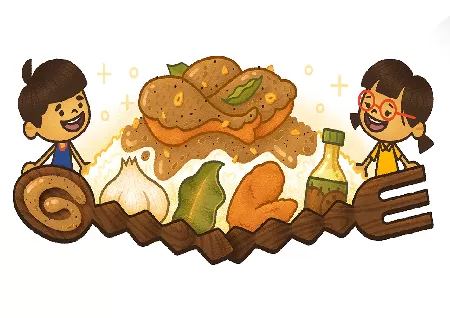Adobo is the first Filipino dish to appear in a Google Doodle

The animated Google Doodle for today honours adobo, the first Filipino dish to be featured on the site.
"Adobo is an integral element of the Filipino story. It is a developing, well-loved comfort cuisine or culinary style that transcends all economic borders. Adobo being featured as a Google Doodle—the first Filipino cuisine to do so—is a proud occasion for Filipinos "said Mervin Wenke, Google Philippines' Director of Communications and Public Affairs.
"It is a pleasure to publish this Doodle on such a worldwide platform that honours the originality and diversity of Filipino food," he said.
Adobo may be found all over the world, whether at a five-star restaurant in Manila or in the homes of Filipino families. The word "adobo" was first added to the Oxford English Dictionary (OED) in December 2006, and it was included in the following OED quarterly update, which was issued on this day in 2007.
There are several varieties of adobo, but they always contain the same fundamental ingredients: marinated pork or veggies cooked into a stew. Vinegar, soy sauce, garlic, bay leaves, and black pepper are common components. As compared to other variations, Filipino adobo tastes significantly sweeter, sourer, and saltier due to the use of native ingredients.
Some regions in the Philippines add a distinct spin to adobo. Locals in Visayas prefer adobong puti (white adobo), which some regard to be the original indigenous form, which utilises only vinegar and no soy sauce. Creamier adobo varieties, such as Adobong Manok sa Gata (chicken adobo with coconut milk), are highly popular in locations like Southern Luzon, where coconut milk is a dietary staple. Some replace beef with seafood, such as squid, or locally available vegetables, such as kangkong (water spinach) or sitaw (string beans).
"Adobo is a source of pride and identity for Filipinos. The mere mention of the word "adobo" would easily make Filipinos everywhere in the globe crave the flavour of home. "There is nothing like our own own Adobo, whether eaten with rice, pandesal, or just on its own," claimed noted restaurant and culinary writer Claude Tayag.
"It is extremely noteworthy to honour adobo as the very first Filipino culinary Google doodle. "This is a fantastic approach to spark significant online conversations about our rich and diverse food heritage," he added.
Google Doodle designer Anthony Irwin remarked on the process: "When working on the art for this Doodle, I ordered some southern-style chicken adobo from a nearby restaurant to relive some memories, and the first thing that struck me was the fragrance. It was so brilliant and nostalgic that it immediately filled my flat with that old feeling: this is how things should be. So I attempted to recreate the basic childlike pleasure of leaning in and tasting the type of meal that makes home seem like home. Mabuti na kain!"
This renowned dish has evolved throughout the years and is now eaten globally. It's a sign and statement of Filipino pride that differs depending on area, family, and taste. The youngsters in today's artwork would undoubtedly agree that the history is vast, the taste is unparalleled, and the fragrances are appealing. Adobo fills bellies and leaves tongues wanting for more wherever and however it is prepared.
Related queries to this article
- Adobo
- Filipino dish
- Google doodle
- Filipinos
Read more articles and stories on InstaSity Trending Topics.